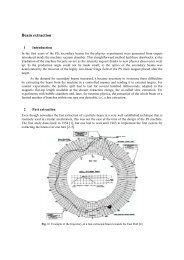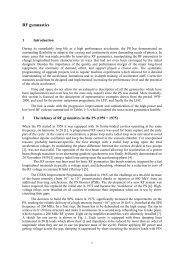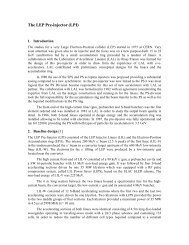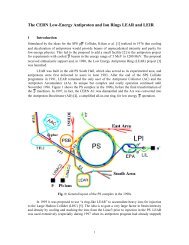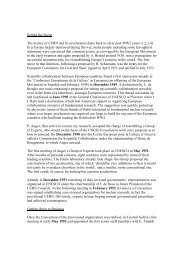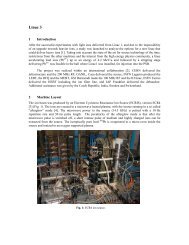Beam extraction - 50th anniversary of the CERN Proton Synchrotron
Beam extraction - 50th anniversary of the CERN Proton Synchrotron
Beam extraction - 50th anniversary of the CERN Proton Synchrotron
You also want an ePaper? Increase the reach of your titles
YUMPU automatically turns print PDFs into web optimized ePapers that Google loves.
7 Implementation <strong>of</strong> MTE at <strong>the</strong> <strong>CERN</strong> PS<br />
7.1 Design principle<br />
The experimental campaign was completed at <strong>the</strong> end <strong>of</strong> 2004. The analysis <strong>of</strong> <strong>the</strong> required modifications<br />
to implement <strong>the</strong> proposed multi-turn <strong>extraction</strong> took place during <strong>the</strong> 2005/2006 long shutdown <strong>of</strong> <strong>the</strong><br />
PS machine. The conceptual design <strong>of</strong> <strong>the</strong> proposed multi-turn <strong>extraction</strong> can be sketched as follows (see<br />
Ref. [44] for more details and Ref. [45] for a complete account <strong>of</strong> <strong>the</strong> hardware commissioning):<br />
– <strong>Beam</strong> splitting: two pairs <strong>of</strong> two sextupoles and one octupole each will separate <strong>the</strong> initial<br />
single beam into <strong>the</strong> five beamlets prior to <strong>extraction</strong>. Contrary to <strong>the</strong> experimental set-up,<br />
where only one set <strong>of</strong> two sextupoles and one octupole was used, <strong>the</strong> choice <strong>of</strong> two pairs is<br />
mainly dictated by <strong>the</strong> need to control and adjust <strong>the</strong> phase <strong>of</strong> <strong>the</strong> islands at <strong>the</strong> <strong>extraction</strong> point.<br />
– Extraction: <strong>the</strong> <strong>extraction</strong> point is in SS16, where <strong>the</strong> magnetic septum for <strong>the</strong> beam <strong>extraction</strong><br />
towards <strong>the</strong> SPS is located. In <strong>the</strong> proposed scheme, <strong>the</strong> electrostatic septum, currently used to<br />
slice <strong>the</strong> beam in <strong>the</strong> context <strong>of</strong> <strong>the</strong> CT <strong>extraction</strong> in SS31, is not required, thus simplifying <strong>the</strong><br />
overall scheme. Two bumps will be used to displace <strong>the</strong> beam towards <strong>the</strong> magnetic septum<br />
blade (slow bump) and to extract <strong>the</strong> beamlets over five turns (fast bump).<br />
– Slow bump: a set <strong>of</strong> dipole magnets (bumpers) will be used to generate <strong>the</strong> slow bump around<br />
<strong>the</strong> magnetic septum. Currently, four bumps powered with a series/parallel circuit are used to<br />
extract <strong>the</strong> beams towards <strong>the</strong> SPS. In <strong>the</strong> proposed scheme, six independently powered<br />
magnets are foreseen. The large number <strong>of</strong> bumpers is imposed by <strong>the</strong> aperture constraints, as it<br />
will allow a careful shaping <strong>of</strong> <strong>the</strong> bump to overcome <strong>the</strong> potential aperture bottlenecks.<br />
– Fast bump: three new kickers will generate <strong>the</strong> fast bump used to displace <strong>the</strong> beam beyond <strong>the</strong><br />
blade <strong>of</strong> <strong>the</strong> magnetic septum. The pulse length should correspond to five PS turns. Since <strong>the</strong><br />
centre core <strong>of</strong> <strong>the</strong> beam needs to be ejected, an additional kick will have to be imparted at <strong>the</strong><br />
fifth turn. For this <strong>the</strong> fast <strong>extraction</strong> kicker will be used.<br />
– Trajectory correction in <strong>the</strong> transfer line towards <strong>the</strong> SPS: even though <strong>the</strong> <strong>extraction</strong> conditions<br />
for <strong>the</strong> novel multi-turn <strong>extraction</strong> do not change from turn to turn, as one single island is used<br />
to extract <strong>the</strong> beam, <strong>the</strong> feed-down effects <strong>of</strong> <strong>the</strong> machine non-linearities (particularly from <strong>the</strong><br />
pole face windings in <strong>the</strong> main magnets) due to <strong>the</strong> <strong>extraction</strong> bumps could generate turn-byturn<br />
variation <strong>of</strong> <strong>the</strong> beamlet position at PS <strong>extraction</strong>. Such an effect could have a negative<br />
impact on <strong>the</strong> emittance after filamentation in <strong>the</strong> SPS. Hence two kickers capable <strong>of</strong> generating<br />
deflection changing from turn to turn will be used in <strong>the</strong> TT2 transfer line to correct for <strong>the</strong><br />
variation in <strong>the</strong> <strong>extraction</strong> conditions (position and angle). These two devices are already being<br />
used for <strong>the</strong> CT <strong>extraction</strong> mode.<br />
7.2 Implementation<br />
The implementation <strong>of</strong> MTE required different interventions, such as design, production, and installation<br />
<strong>of</strong> new octupoles; construction <strong>of</strong> new power converters for <strong>the</strong> new <strong>extraction</strong> bump; design,<br />
construction, and installation <strong>of</strong> new vacuum chambers for increasing <strong>the</strong> beam aperture in particular in<br />
<strong>the</strong> <strong>extraction</strong> region; construction <strong>of</strong> new <strong>extraction</strong> kickers and <strong>the</strong>ir Pulse Forming Network (PFN). A<br />
large fraction <strong>of</strong> <strong>the</strong> PS circumference was affected by those interventions, summarized in Fig. 29, and<br />
24



